Abrasive paper (sandpaper, sandpaper or abrasive paper): types and classification
For grinding, leveling wood, metal, stone, plastic, abrasive materials are used. For manual finishing or using hand sanders, sandpaper is needed. This is a material with a rough surface. The degree of "roughness" determines the grit size of the sandpaper. What is it and how it is chosen, what other types of sandpaper can be, how to choose it. We read about all this further.
The content of the article
What is sandpaper
Emery, sandpaper (or just sandpaper), sandpaper, abrasive paper, or sandpaper are all names for the same material. This material is a flexible abrasive for manual or hardware processing of various materials. There is emery for metal, wood, plastic, glass. Sometimes they are also used for processing plaster and putty, but for these purposes, a sanding mesh may be more convenient. It doesn't clog that way.
Abrasives for abrasives are small particles of hard materials of different sizes. These particles are called grains and their size is called grit. They are glued to a flexible base. Sanding / abrasive paper-based abrasive paper is more common. This is the cheapest kind, but not the most durable. The fabric base is more reliable, but it can stretch, which is also not always convenient when working. Polyethylene-based emery is a waterproof abrasive. This is the most expensive type, but it can work even in water. For wet processing, emery on water resistant paper is also used.
Emery paper is used to eliminate irregularities and defects, to obtain a smooth surface, grinding and polishing. So sanding can be rough or fine. Coarse means the removal of paint or rust, burrs, and the initial leveling of the surface. For this work, a material with large (from 500 microns to 1 mm or more) and medium (from 200 microns to 500 microns) grain is used. Getting a flat and smooth surface - grinding, polishing - this is already a fine or finishing treatment. For this type of work, a fine grain sandpaper (less than 200 microns) is used.
Forms of release and types
The usual form of release is in rolls or sheets. Sheet can be based on cardboard, or it can be on thick paper. Most often it is more rigid than roll. Roll is more often used on belt grinders, and also for manual use. In addition, there are the following types of abrasives:
- Abrasive wheels. Used to mount on attachments for special machines. These can be grinders, drill bits, angle grinders. There are different types:
- Ordinary circles of different diameters and different grain sizes.
- With Velcro, glued on the back.
- Petal is when strips of sandpaper are glued to the base. They can be of different grain sizes. They are used for rough processing of metals (usually), for removing paint (including from concrete).
- Belts for belt sanders.They have a certain length and width - for the most common standard sizes.
- Grid. Thin wire intertwined in the form of a web. Abrasive particles stick to the wire. Such material is convenient for grinding plaster, since most of the resulting dust spills through the mesh cells and the abrasive does not clog. It is this material that is used to level gypsum plaster for painting.
There are also grinding sponges. This is an abrasive that is applied to polyurethane foam. This type of abrasive is used to smooth surfaces with grooves, threads, recesses. Abrasive particles can be applied to one, two or four sides of the sponge. They can be of the same size or different. But usually, this is a small grain, just different degrees of "fineness". Sponges are more convenient, as they take any shape, in addition, they can be washed from dust and dried. The number of flushes is not limited. They do not suffer from washing, they can be used while the grain is not crumbled. And it depends on the quality.
Types of sandpaper grit
As already mentioned, the grit size of the sandpaper is the size of the abrasive fragments. They are measured in micrometers. The smallest grain that is found in sandpaper is only 3-5 microns, the largest is 1000 microns (this is 1 mm). According to the grain size, fine-grained and coarse-grained abrasives are distinguished.
Russian standards
In order to be able to understand what specific material is in front of you, the size of the abrasive grain is indicated in the marking. But with her, it's not so simple. During the Soviet era, GOST (3647-80) was introduced, the designation according to which still exists, although in 2005 a new standard was introduced (GOST R 52381-2005), which was developed on the basis of European standards. The difference between the old and new GOST is significant.
- Old standard the minimum grain size is prescribed. That is, the larger the number, the larger the grain. But we must bear in mind that some of the grains are smaller. In addition, the marking (letter designation) is different for coarse and fine grain. This is worth remembering.
- For coarse emery, the grit of the sandpaper is indicated in microns, and after it they write the letter H with a hyphen in front of it - "H". For example, 63-NThis means that the minimum grain size on emery will be 63 microns or 630 micrometers (μm). But there will also be larger particles. How much larger? Slightly smaller than the previous brand. In this case, only 80-H is larger than 63-H, that is, the grain will be slightly less than 800 microns. The second example is 6-H. The grain size is no more than 6 microns or 60 microns, and the largest ones will be no more than 80 microns (since the previous grade 80-N).
| Grain marking of sandpaper according to GOST 3647 | ISO 6344 marking (GOST 52381-2005 Russia) | Grain size in micrometers (μm) | Scope and types of work |
|---|---|---|---|
| 80-R | P22 | 800-1000 | Rough machining of steel, other metal, wood, removal of rust, burrs |
| 63-N | P24 | 630-800 | |
| 50-N | P36 | 500-630 | |
| 40-N | P40 | 400-500 | Rough woodwork, primary wood sanding |
| 32-H | P46 | 315-400 | |
| 25-N | P60 | 250-315 | |
| 20-N | P80 | 200-250 | Smoothing, Primary grinding. Plasters, wood, metal |
| 16-H | P90 | 160-200 | |
| 12-H | P100 | 125-160 | |
| 10-H | P120 | 100-125 | |
| 8-H | P150 | 80-100 | Removing paint, sanding metal and soft woods, preparing for sanding hard woods |
| 6-H | P180 | 63-80 |
-
- When marking of fine sanding cloth the grain size is indicated in micrometers, and after the number put the letter "M"(No hyphen). Example: 14M. This means that the maximum grit size of the emery paper is 14 micrometers, but there are also finer grit sizes up to 10 microns.
- According to the new standard (GOST R 52381-2005) the grit size of the sandpaper is indicated by the number of sieve fibers through which the abrasive is sieved. It turns out that the lower the number, the larger the grain. The letter "P" is placed before the number.
| Sandpaper marking according to GOST 3647-80 | Sanding paper marking ISO 4344 (GOST 52381-2005 Russia) | The grain size of the abrasive paper in micrometers (μm) | What works to use |
|---|---|---|---|
| 5-H or M 63 | P240 | 50-63 | Leveling before painting and starting sanding hard rocks |
| 4-H or M 50 | P280 | 40-50 | |
| H-3 or M 40 | P400 | 28-40 | Final leveling for painting, wood sanding |
| H-3 or M28 | P600 | 20-28 | |
| N-1 or M20 | P1000 | 14-20 | Grinding metal, plastic, ceramics, wet lapping to smooth wood |
| M14 | P1200 | 10-14 | |
| H-0 or M10 | R1500 | 7-10 | Ultrafine polishing of metal, finishing to the gloss of plastic, wood |
| H-01 or M7 | P2000 | 5-7 | |
| H-00 or M5 | P2500 | 3-5 |
As you can see, it's already pretty confusing. It should also be said that, according to the old standard, fine-grained emery can have a double designation - with the letters M and H - as in the table. Moreover, more often it was the options in microns that were in use. Therefore, the finest grain - 5M or 00-N - is often called zero. This is because it is 3-5 micrometers in size. This can be considered zero by rounding rules. This is where the name comes from.
Compliance tables for other countries
As you can see, the situation is not easy. And there is also American ANCI (USA and Canada), European FEPA or its other name ISO 6344, Japanese JIS and Chinese GB2478. Moreover, on the market you can find material from almost all these countries / parts of the world. So it is desirable to have at least some data. The most common ones are shown in the tables.
Note that the grain sizes in micrometers (μm) are written next to each column. The sizes are different. For work, this can be important.
Sandpaper marking
Sandpaper marking is a set of letters and numbers, which encodes complete information about the type of substrate, abrasive, application method, composition and grain size. We have already examined the graininess. This parameter appears at the end of a series of letters and numbers. It's more or less clear with him. In general, the marking of sandpaper displays the following data (starting from the first character):
- what material the grain is made of;
- the base of the skin;
- a binder with which the grain is glued to the base;
- methods of applying grain;
- type of base (paper or fabric);
- water resistance (if not water resistant, there is no badge);
- grit of sandpaper.
Let's deal with the rest of the characteristics that are encrypted in the marking. The letters are in Latin. Let's take, for example, what the following marking means: KK19XW. So:
- first K - type of abrasive - normal fused alumina;
- second K - base - cotton fabric;
- 1 - two-layer application of a binder (resin + resin).
- 9 - the type of application is unclear;
- X - type of textile - hard.
- W - indicates that the material is waterproof.
Next, there should be the letter P and the numbers by which the grain size of the emery is determined.
Abrasive types
The first letter in the marking indicates the material from which the abrasive is made. It is the abrasive material that is responsible for how much effort must be applied during processing. The stronger it is, the longer you can work with one piece of skin. Unfortunately, the rule here is that the better, the more expensive.
- K - "normal" electrocorundum. The abrasive is brown (shades may vary). The most common and relatively inexpensive material.
- C - silicon carbide. Very durable material. For a long time it is not erased and clogs a little. For glass and plastic processing, for finishing metal polishing.
- G - zirconium fused alumina. It has a brick-red color due to the addition of zirconium. Differs in increased wear resistance, but is more expensive than "usual".
- A - alloyed electrocorundum. Has the addition of titanium, which gives it a blue color. The most, perhaps, durable. Recommended for sanding difficult to process materials.
- V - white fused alumina. Differs in white due to the large amount of aluminum.
- S - ceramic fused alumina.
If, looking at the photo, you decide that the emery is tinted, then in vain. Various additives used in the manufacture of abrasive substances give it different colors. Another thing is that most often we see brown, gray or dark gray sandpaper for grinding. They are simply the cheapest and most popular.
Base types
The base of the abrasive is the material on which the abrasive is glued. This material determines the degree of flexibility, deformation resistance. It also depends on the base whether this type of sanding can be used for dry or wet sanding.
In the marking, the type of base is encrypted with the second letter.
- Woven base. Cloths are woven from cotton and synthetic fibers:
- K - cotton fabric. High strength, wear resistance, not afraid of getting wet. Among the disadvantages - it can lengthen during operation. This is bad for belt sanders.
- X - polyester textile. Compared to cotton, it is more wear-resistant. It is used to manufacture tapes of various widths. The base is dense. It can stretch slightly when filling in grinders and does not deform for a long time.
- Y is synthetic. It is used in the furniture industry for grinding wooden panels. Withstands very heavy loads.
- J - elastic cotton fabric. It is used for processing minor relief.
- JJ or F - cotton fabric with increased elasticity. These types of warp are for narrow belts, for deep relief processing. Stretch and bend very well.
- P - paper base. Inexpensive, even very fine grains can be applied. Zero and other fine grain abrasives on this basis. Cannot be used for wet grinding (with water supply) without additional impregnation. Emery paper comes in different weights. A fine abrasive is applied to a less dense one, a coarse one to a denser one. These types of abrasive papers are:
- A - density 90 g / m², B - 110 g / m². For chalkwho grain. Flexible, bends well, tho facilitates finishing work.
- С - density 125 g / m², for medium size abrasives. This type is the most popular. Can be in rolls or thin sheets.
- Density of paper D - 150-180 g / m², type E - 220-250 g / m². This is the basis for coarse grains. Usually available as sheets (hand-applied) and narrow belts, disks for vibration grinders.
- Rigid papers F (270 g / m²) and T (300 g / m²) are the basis for very coarse grains. It is used to make wide belts for large grinders.
- F - fiber. Thick and durable canvas. Used for discs. Absorbs water and is therefore not suitable for wet sanding.
- C is a combined base. It is heavy paper, glued on one side with a cloth. The fabric makes the paper more resistant to deformation, it lasts longer. They are usually used for large grains.
- T - latex paper. This is a specialized type of foundation that DIYers do not use due to its high cost.
If we talk about the base, then the cheapest paper-based emery. It is usually used for manual processing or attached to a hand grip. For grinders, a woven base is often taken. But cotton or polyester is your choice. Who likes what more.
Binder
In the third position in the marking of the abrasive paper there is a number that encodes the method of fixing the abrasive on the base. Use glue or polymer resins, combinations thereof. The glue "adheres" well to the abrasive and the base. One-layer application of the binder (on the marking with the number 2 in the corresponding position) is used where the emery is not subjected to heavy stress.
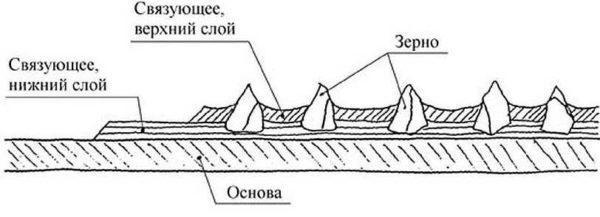
Methods for gluing abrasive to the base. Glue or resin is used, combinations thereof in different order
For a stronger hold of the grains, a second layer is poured over the glue.Most often it is a resin (phenolic or any other). It turns out a bunch - glue + resin (number 3 in the marking). The second layer of binder makes the emery more abrasion resistant.
There is another option - resin + resin (this is 1 encoded). That is, both the first and second layers are made of bakelite resin. The cost of this option is higher, which determined its area of use - production.
Method of applying and pouring grain
There are two ways to apply grain to the primary binder layer: free and electrostatic. When free, the abrasive particles are simply poured. They lie in a free order, their direction is random. In the electrostatic method of grain filling, the paper is passed through an electric field. As a result, the grains have the same orientation, which makes the surface rougher.
In addition, there are two types of grain filling: open and closed. They differ in the number of particles per unit area. With an open backfill, sharp fragments are located at a distance from each other, the base is visible (open). This paper works well with loose materials. For example, with wood. Wood dust wakes up, the abrasive does not clog.
Closed filling of grain on emery is denser. The abrasive particles lie next to each other, the base is practically closed, not visible. This type of sanding paper is good for tough materials (steel, for example).
What should be the grit of sandpaper for work
As you can imagine, different sanding paper is used for different processing of materials. Now it's not about the form of release, but about the size of the grain, the way it is applied. The type of abrasive and application method are of secondary importance. They more affect the durability of the material. But as usual, better means more. Here everyone chooses for himself. But the grain size is better to select for specific tasks.
What sandpaper to grind wood
To prevent the skin from clogging, the grain must be applied at intervals. This is an open type of application. In this case, you do not have to often "knock out" or change it. Base type - paper or fabric. Paper is cheaper, fabric is more expensive. If there's grinder, see the recommendations for it. For processing by hand, you can attach a piece to a special holder or nail it to a block.
Recommendations for the choice of grain size are given in the table. For primary processing, sandpaper from P40 to P80 is used. This is shaping, removing a thick layer. We use the same materials to remove varnish and paint from wood. To prepare the tree for painting, you need P100 to P240. For sanding after applying the first coat of varnish, take P360 or P400. And finishing to smoothness - actually polishing and varnishing - these are already very small P500 and higher. In general, polishing is a separate topic, and there you need to grind step by step and apply paint or varnish. And each time the grain is taken more and more subtle. And they finish polishing with a generally soft polishing (felt) material.
What kind of emery to process metal
For metal processing, you will have to take harder abrasive materials, which means more expensive ones. Normal corundum will cope with aluminum and its alloys. They also process cast iron, bronze and black steel. For brass, you need at least zirconium, but titanium or alloyed alumina is better. And even better - ceramic. Also note - the application method must be closed.

For grinding and polishing metal, a different type of skin is needed, and we select the grain size for the type of work
The principle of selecting the grain size is the same: for coarse processing the increased "roughness" of coarse grains, the finer the processing, the finer the abrasive. To remove rust and level the main roughness, take the coarsest sandpaper. The thinner the layer, the smaller the grain size. So everything is logical here.But note that there are two or three grit sizes for each job. This does not mean that you need to take any of the above. This means that each size must be processed to get a good result. Although, if appearance is not so important to you, then you can use one of the recommended sizes.
Sandpaper for plastic, stone, ceramics and glass
As for the type of abrasive and its application, the recommendations are the same: stronger, more dense arrangement. But sanding is recommended with water supply, so a waterproof modification of the emery is required.
For finishing plastic and glass, even the smallest grit sandpaper - the same zero or P800 - will be too rough. It will leave visible scratches. These materials are brought to smoothness with the help of GOI paste and even thinner grinding compositions. But this is a separate story and its own technologies.

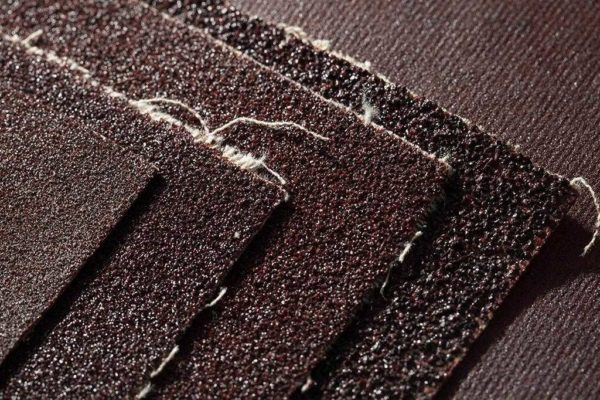
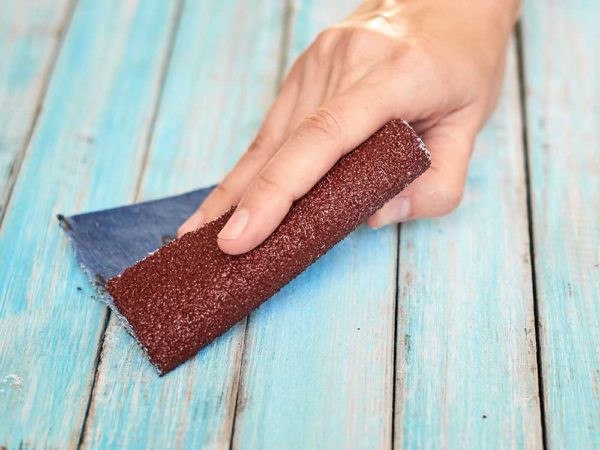
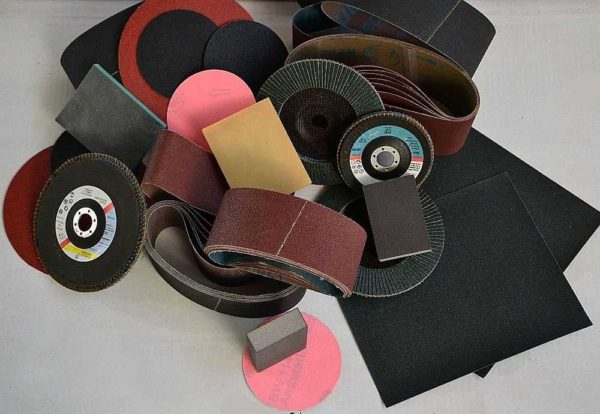
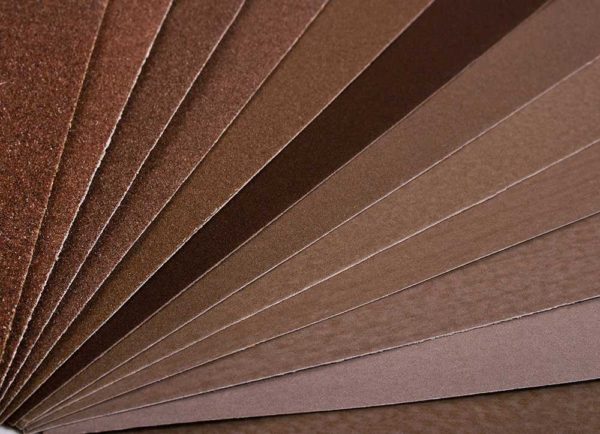
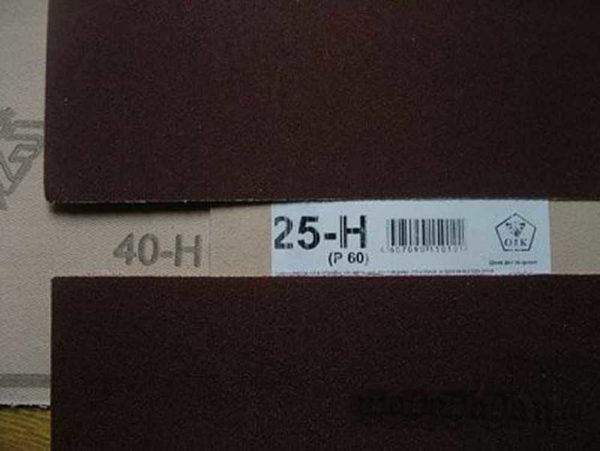
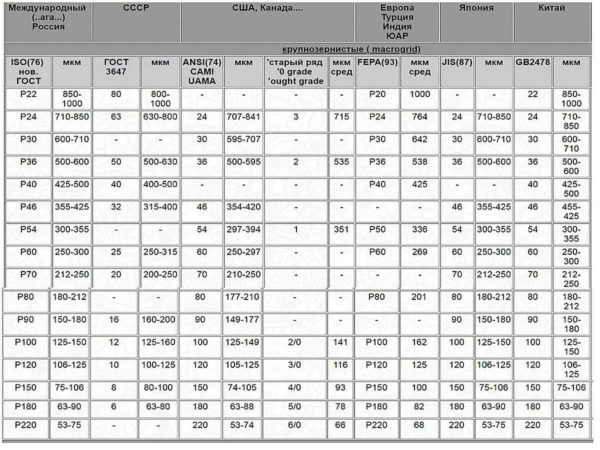
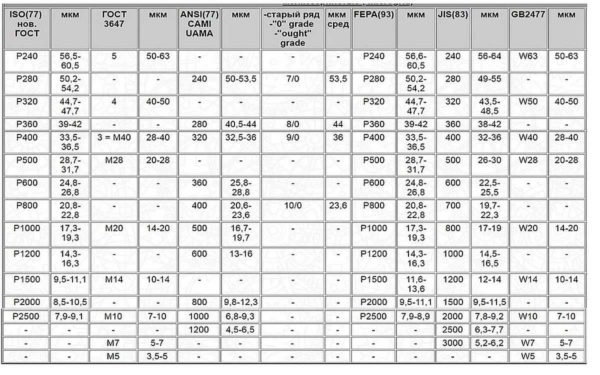

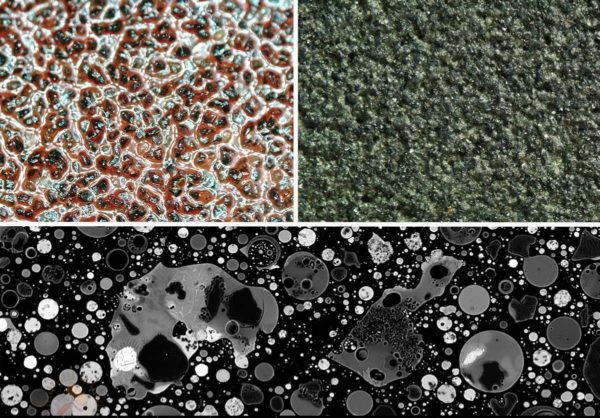
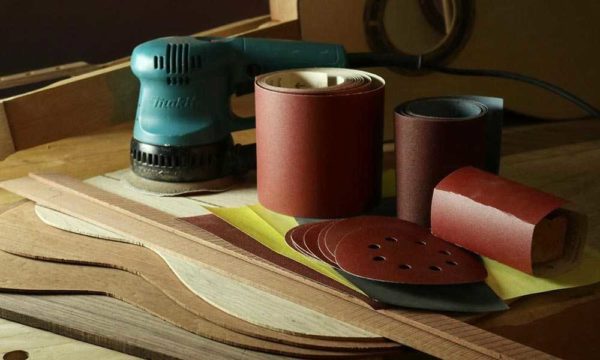
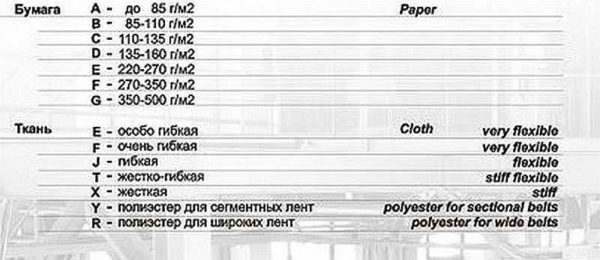
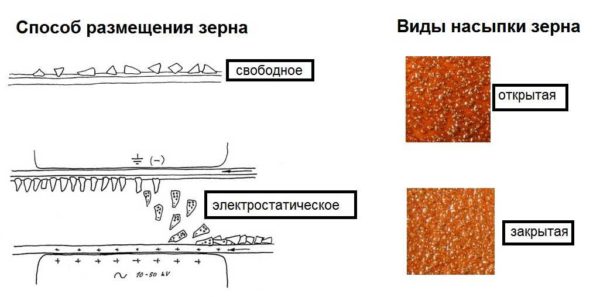
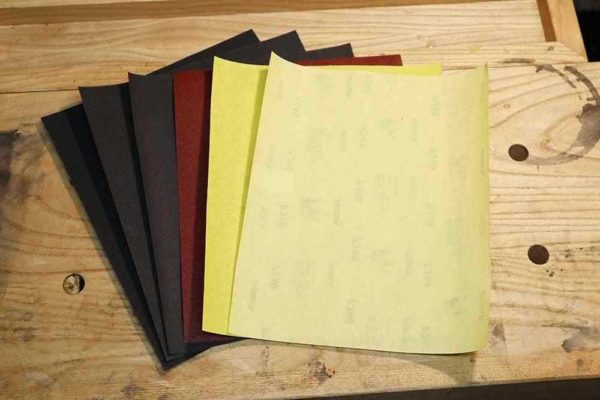












Satya is very helpful. But I found a discrepancy: the words "micron" and "micrometer" in the Soviet school meant the same thing, a millionth of a meter. Only "micron" is an abbreviated name for "micrometer", the teachers liked to give it a special designation with the Greek letter "mu" (this letter is not in my keyboard). If I am right, then the introductory part of the article should be corrected, otherwise you will not understand anything about the grain size.
You are right, there was an inaccuracy in the description. Fixed. Thank you.
Not fixed, whole plates are wrong. Cuts eyes